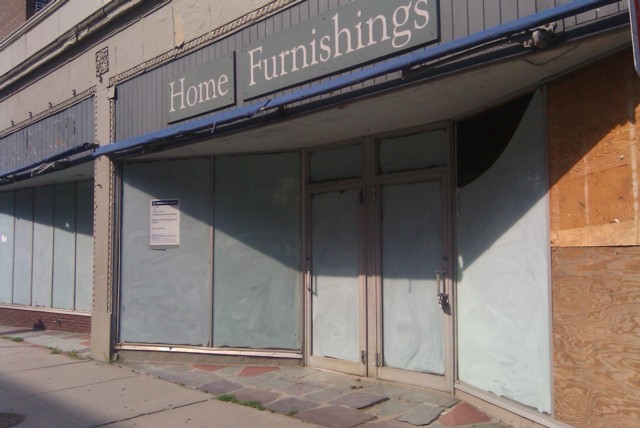
Retailer in Cambridge, Massachusetts near Harvard University one year after closing.
The End of the Nominal Recovery - Part I: Boarded Up
Double-dip recession talk is all the rage. ``More spending, the depression is here!'' yells Paul Krugman in today's New York Times. We told you that monetary and fiscal stimulus can halt a deflation spiral, but central banks and governments can't print purchasing power. A year after the stimulus the negative impact of reflation, the crowding out of private lending by government lending, starts to be felt as the economy grows in nominal terms but shrinks in real terms. A recession can't return if it never really went away in the first place.
This article follows up on FIRE Economy Explosion Fallout -- Part I: Recession ends, depression begins, July 2009.
For U.S. home and auto buyers it’s 1983 again, when the Cabbage Patch Kids doll fad started, President Reagan committed billions to a doomed crackpot high tech defense program called Star Wars, the Soviets shot down a Korean airliner, the U.S. embassy in Beirut was bombed, and the economy staggered under the Volcker Fed’s program of double-digit interest rates.
A 20-year economic boom followed the Fed’s controlled demolition of the U.S. economy. Interest rates fell for decades, housing, bond, and stock prices inflated, and the economy grew four fold.
One year after the official end of the recession caused by the uncontrolled crash of the FIRE Economy between 2007 and 2009, the economy shows no signs of booming. Emergency Keynesian policy measures taken to keep the debt crisis from devolving into a 1930s deflationary spiral show signs of losing effectiveness, and the self re-enforcing economic growth story is giving way to talk of a “double dip” recession as trouble in Europe is expected to slow the U.S. economy by the end of the year. Confidence in the resilience of the recovery is waning.
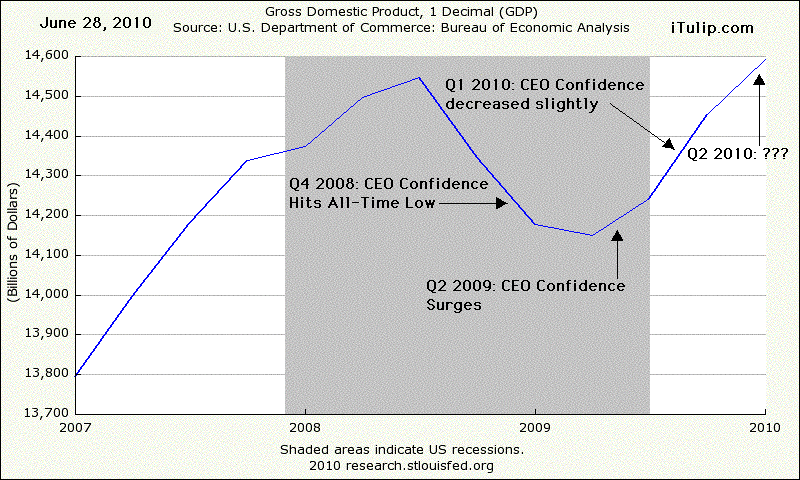
Quarterly CEO Confidence Survey results correlated to quarterly GDP.
CEO Confidence Survey noted the bottom of the recession and the beginning of recovery. CEO confidence dipped slightly in Q1 2010 for the first time since Q1 2009, to 62 from 64 in Q4 2009 (a reading of more than 50 points reflects more positive than negative responses). The Q2 2010 data are due out the week of July 5. A decline in CEO confidence below 50 points will strongly support leading economic indicators that are pointing to a second recession.
The last time the economy struggled under the weight of public debt taken on to stimulate demand after a private-sector credit collapse was during The Great Depression. Is the nation’s balance debt-heavy sheet able to finance ongoing stimulus spending without triggering a U.S. debt and currency crisis? The question is once again divided along ideological lines; it’s 1937 all over again as Democrats and Republicans battled in the Senate last week over how to pay the $141 billion cost of new legislation that extends unemployment benefits to more than two million who remain unemployed a year after the recession ended.
What if a second recession arrives while we’re still arguing about what to do about the after-effects of the last one?
It’s not “coming back”
Even if we dodge a double-dip recession, conditions of the economy and debt markets are the opposite today of 1983, the last time new home and car sales were this slow. Without a tail wind of falling interest rates and low debt levels, for the next 20 years inflation and interest rates will rise as policy seeks to deflate debt against wages and the dollar; real housing prices and wages decline.
A year after touring the aftermath of the Housing Bust Recession, many retailers remain closed, windows once whitewashed are now broken, boarded up, and festooned with graffiti.
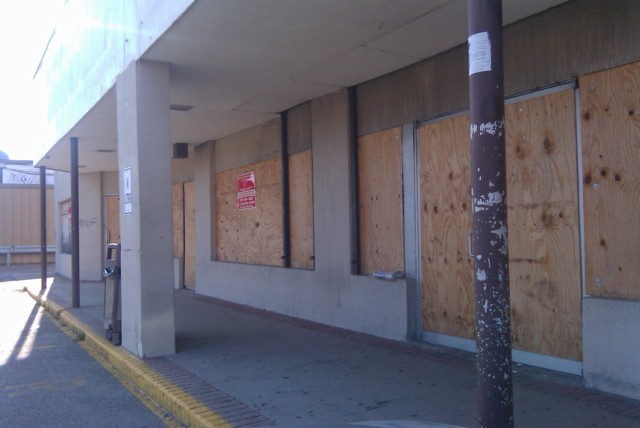
Retailer in Alston, Massachusetts one year after closing. Broken windows are now boarded up.
That remains true for the financial system that got a whitewash but has yet to receive even a partial renovation. The financial reforms package passed last week does nothing to take the guys out of circulation who created the crisis, leaving the ethical bankers to compete with the ethically-challenged, who will no doubt quickly find a way around the new rules. I recommended a bad bankers amnesty program to a well-known regulator, but he disagreed. As long as reform is bent on punishment and not on fixing the problem, I don’t see how we make progress on repairing the still-broken private credit markets.
Last week dismal home sales matched auto unit sales at a level not seen since the end of the early 1980s recessions when a nearly continuous three-year downturn was created on purpose by the Volcker Fed with double-digit interest rates to halt and reverse an escalating inflation spiral.
Home sales fell to an annual pace of 300,000 units this May, the lowest yearly unit volume since 1983, after three years of the Fed’s punishing high interest rates that sent the economy into the worst economic contraction since The Great Depression.
An optimist might conclude that home and car sales are thus only as bad as in 1983, except that the economy was only one quarter the size of today’s; this post-recession housing market contraction is proportionally four times worse than the housing downturn that occurred at the end of the early 1980s recessions.
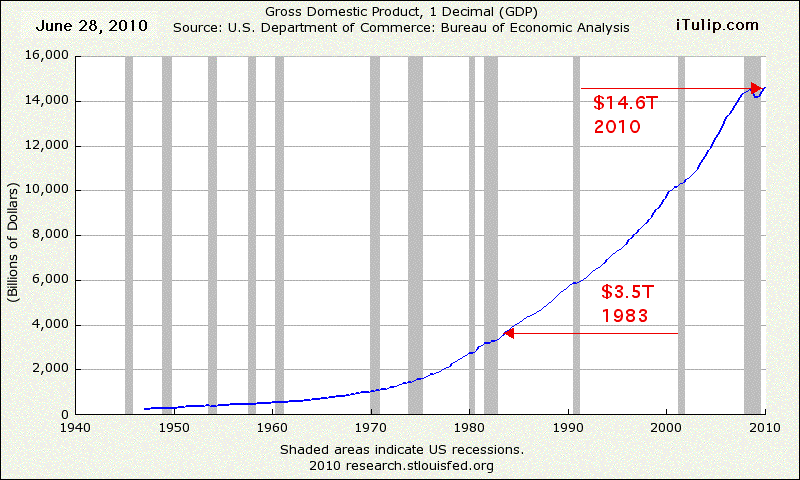
U.S. economy is four times as large today as the last time new homes sales were this slow.
The May 2010 collapse in new home sales to 1983 levels occurred despite 30-year mortgage rates at levels not seen since 1971. Today’s 4.69% rate on a 30-year mortgage is less than half the 13% rate paid by borrowers the last time new home sales were this weak.
In 1983, mortgage rates had only one way to go – down –as disinflation proceeded for decades, although they took a detour to 15% in the two years that followed.
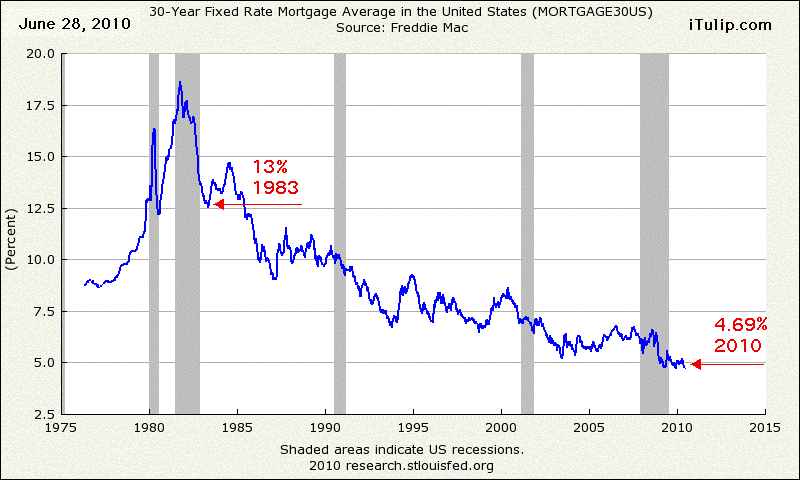
Mortgage rates are at an all-time low.
The ultra low rates result from the Fed’s continued purchases of mortgage-backed securities from banks. With $1.1 trillion of MBS on its balance sheet as of early June, starting from zero in January 2009, the Fed can’t find private hands to offload the securities onto and instead uses them as collateral at full market value for new loans, despite the fact that the market value is virtually nothing, as evidenced by the unwillingness of private institutions to buy them.
BusinessWeek reported Thursday:
Borrowing costs have tumbled in the past two months as concern that a debt crisis in Europe may spread boosted demand for the safety of bonds including mortgage-backed securities. The lower rates have failed to lift housing demand, which has tumbled since a tax credit for first-time and certain other buyers expired at the end of April.
The average price of $5.2 trillion of bonds guaranteed by government-supported Fannie Mae and Freddie Mac or federal agency Ginnie Mae climbed to 106.3 cents on the dollar yesterday, according to Bank of America Merrill Lynch’s Mortgage Master Index. That’s up from 104.2 cents on March 31, when the Federal Reserve ended its program purchasing $1.25 trillion of the debt.
But did the Fed really stop buying MBS?The average price of $5.2 trillion of bonds guaranteed by government-supported Fannie Mae and Freddie Mac or federal agency Ginnie Mae climbed to 106.3 cents on the dollar yesterday, according to Bank of America Merrill Lynch’s Mortgage Master Index. That’s up from 104.2 cents on March 31, when the Federal Reserve ended its program purchasing $1.25 trillion of the debt.
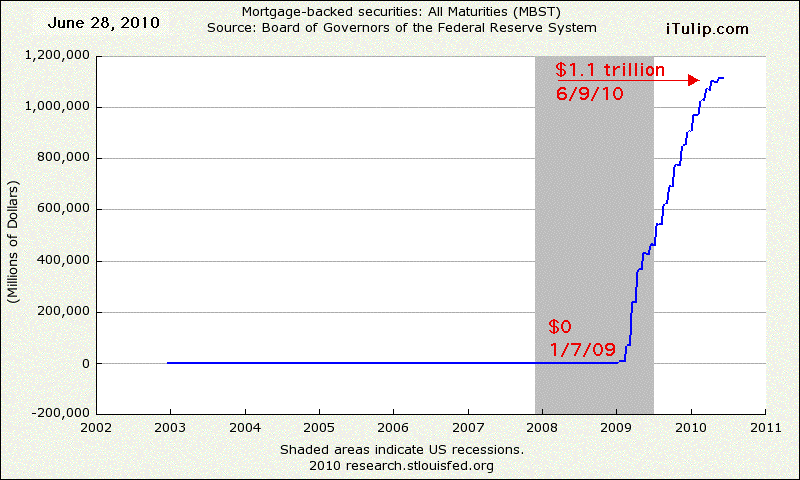
The Fed planned to stop buying MBS at the end of this March yet Fed MBS balances
have increased by $45 billion since March 31
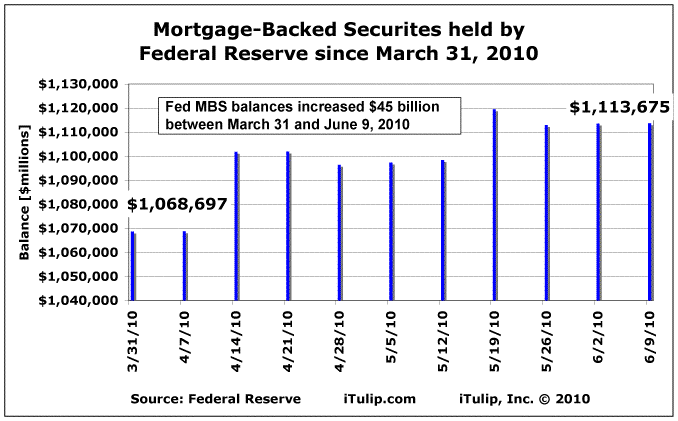
Fed MBS balances rise $45 billion since March 2010 despite announcing plans to
discontinue the purchase program.
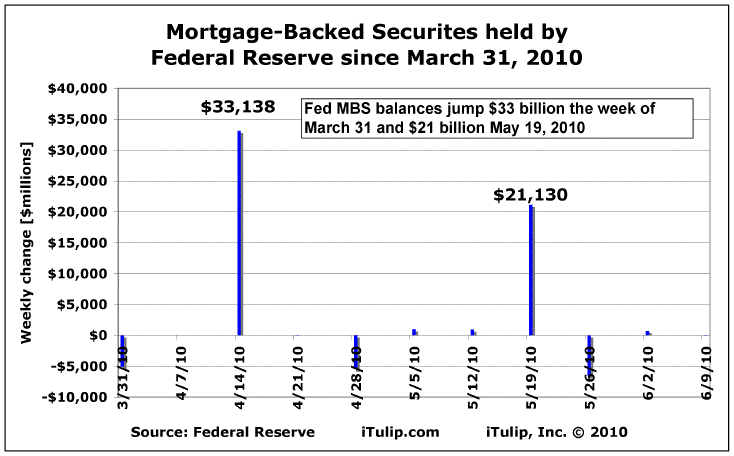
Most of the increase occurred in two one-week periods
discontinue the purchase program.

Most of the increase occurred in two one-week periods
What will happen to the housing market when the Fed finally does begin to lower its MBS balances?
The stimulus to the FIRE Economy from declining mortgage rates between 1985 and 2005 cannot be over-estimated. When 30-year rates dropped from 15% in 1985 to almost 5% in 2005, the monthly mortgage cost and interest expense on the average home fell by half. For a $250,000 mortgage on a $300,000 home, at 15% the monthly payment was $3,526 with $894,250 in interest paid for a total of $1,269,250 in 360 payments. The same mortgage at 5% carries a monthly payment of $1,707 with $248,660 in interest paid and a total of $614,390 in 360 payments.
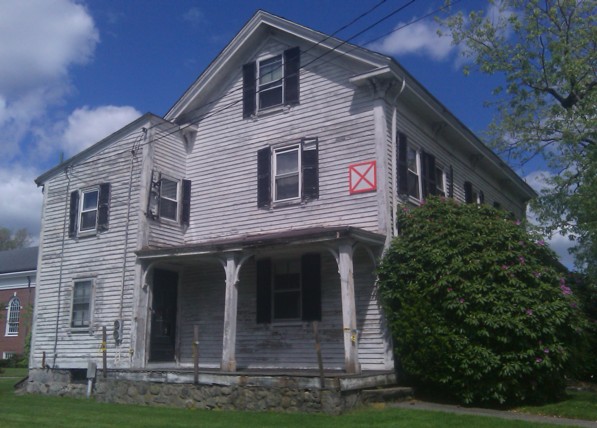
Condemned house in Lexington, Massachusetts.
We are interviewing Michael Hudson via email to try to figure out the meaning of the Fed MBS balance increases since the end of March when the Fed ostensibly stopped buying them from the banks and we’d expect balances to either level off or even decline.
Mortgage rates can only go up over the next ten years and home prices have only one way to go: down. The VAT will eventually win, inflation will rise, and real wages will fall some more. That's the best case scenario, a continuation of a nominal but not a real recovery.
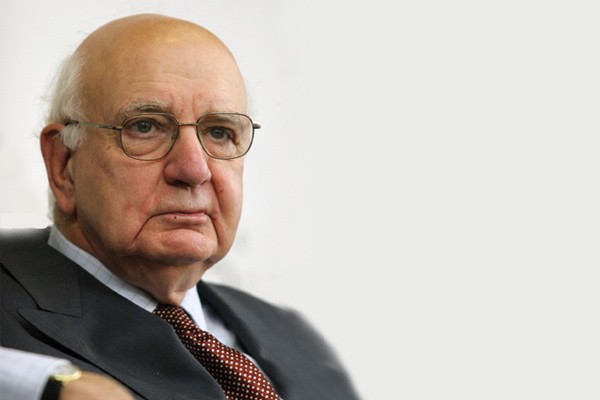
Ex-Fed Chairman Paul Volcker
The End of the Nominal Recovery - Part II: Countdown to Calamity
Last week I attended an interview of ex-Fed Chairman Paul Volcker put on by The American Counsel on Germany at the University Club in NYC. The interview was an off-the-record affair attended by the usual Wall Street suspects – investment bankers, hedge fund managers, wealth managers, consultants, and so on. I can’t report directly on what the man said. Instead, I repeat the question I asked him, and our community interviewer CI then asks me a series of questions to bring out Volcker’s main points.
Mine was the final question of the Q&A period that framed the last ten minutes of the one-hour interview. “You may recall we had some inflation in the late 1970s,” I began. That got a good laugh. Volcker turned to his interviewer on stage and joked, “Inflation? We had inflation in the 1970s?” Then I went on to ask:
“Is it fair to say that the great inflation of the late 1970s provided a clearly identifiable and urgent crisis that acted as a forcing function for political consensus across a wide range of interest groups? Everyone knew the inflation had to be stopped and quickly. You were able to take action without a vote from Congress. You raised short-term interest rates to 6% over the double-digit rate of inflation, and not only the United States but the world economy adjusted to it. The U.S. was a creditor then that could act unilaterally, irrespective of the impact of U.S. policy on other countries.
"Today none of these conditions that are needed for consensus to conduct unpopular but necessary domestic economic policy exist for the U.S. Now we are a debtor country that must coordinate domestic monetary and economic policy decisions with our creditors. We don’t have a crisis that presents a clear and present danger but antecedents to crisis, notably $60 trillion in contingent liabilities and a mortgage industry that is, in your words, ‘a ward of the state.’ Today there isn’t even agreement that this presents a clear danger, never mind a present one. Even if there was general agreement on the danger that our fiscal position presents and a consensus could be achieved on policy measures to address it, most critically spending cuts, getting spending cuts through a gauntlet of special interests in time to avoid a crisis is highly unlikely.
"Do you believe that the antecedents to a crisis will persist and grow until a new crisis occurs that provides a forcing function for political consensus once again to address it? If so, what is that crisis likely to be and when might it occur?”
He thought for a moment, then looked me in the eye and answered at length, starting with a recount of the political atmosphere surrounding the 1970s inflation and concluding with an assessment of the future. more... ($ubscription)"Today none of these conditions that are needed for consensus to conduct unpopular but necessary domestic economic policy exist for the U.S. Now we are a debtor country that must coordinate domestic monetary and economic policy decisions with our creditors. We don’t have a crisis that presents a clear and present danger but antecedents to crisis, notably $60 trillion in contingent liabilities and a mortgage industry that is, in your words, ‘a ward of the state.’ Today there isn’t even agreement that this presents a clear danger, never mind a present one. Even if there was general agreement on the danger that our fiscal position presents and a consensus could be achieved on policy measures to address it, most critically spending cuts, getting spending cuts through a gauntlet of special interests in time to avoid a crisis is highly unlikely.
"Do you believe that the antecedents to a crisis will persist and grow until a new crisis occurs that provides a forcing function for political consensus once again to address it? If so, what is that crisis likely to be and when might it occur?”
Tulip Select: The Investment Thesis for the Next Cycle™
__________________________________________________
To receive the iTulip Newsletter or iTulip Alerts, Join our FREE Email Mailing List
Copyright © iTulip, Inc. 1998 - 2010 All Rights Reserved
All information provided "as is" for informational purposes only, not intended for trading purposes or advice. Nothing appearing on this website should be considered a recommendation to buy or to sell any security or related financial instrument. iTulip, Inc. is not liable for any informational errors, incompleteness, or delays, or for any actions taken in reliance on information contained herein. Full Disclaimer
Comment